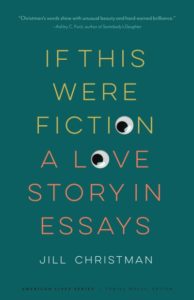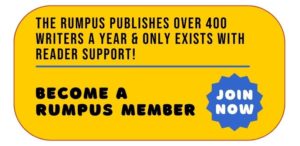
While reading Jill Christman’s If This Were Fiction: A Love Story in Essays, I thought of the line from French philosopher Simone Weil: “Attention is the rarest and purist form of generosity.” Those two bookended nouns perfectly capture the power of this collection. Christman has paid profound attention to her life, her relationships, to experiences ordinary and cataclysmic, to who and what she’s loved and lost. And this makes her a generous writer: with the attention she brings her subjects comes the prospect that the reader’s stories might matter, if we dare to consider ourselves just as keenly. Attention itself is just a form of love, and Christman grants her audience plenty of both in this work.
The book opens with a micro-essay, “The Sloth,” where Christman lays the foundation for some recurring themes: how we see ourselves in relation to others, how we observe, how we endure the slow crawl of grief in all its temperatures. On the sentence level, it is varied, rhythmic, specific. It opens with Christman swimming in the sea off the eastern coast of Costa Rica just months after her fiancé is killed in a car accident. Later, in an outdoor shower, she encounters a “mottled and filthy” three-toed sloth. The last paragraph begins this way:
“What else is this slow? Those famous creatures of slow—the snail, the tortoise—they move faster. Much. This slow seemed impossible, not real, like a trick of my sad head. Dripping and naked in the jungle, I thought, That sloth is as slow as grief.”
The em-dashed interruption of the snail and tortoise work to slow down the sentence, and of course, so does the single word sentence, “Much.” Christman’s “sad head” is a repeating reference that begins here, though a reader can see, even within that expression, her head is not only sad, but playful, finding the absurdity among life’s painful and mundane moments in equal measure. However she might characterize her thoughts, I’d follow them anywhere.
Like to Plum Island. The book’s second, sprawling essay, “Going Back to Plum Island,” works like a personal detective story, with readers serving as co-investigators of the long-term sexual abuse by a neighbor that Christman endured as a child. The events that inspired this return to the neighborhood reveals a significant truth about trauma narratives: they rarely come with a tidy-bow structure of beginning (trauma occurs), middle (trauma endured), and end (trauma overcome), wrapped in a sleek package of “I’m all better now!” The oscillation of stages of recovery and resiliency unfold beautifully where, as Christman admits, “it’s hard to find your bearings.”
Certain essayists tend to grant their child-narrator selves more wisdom or precocity than they ever had to begin with, intimating that their ideas about the world have been correct from the start. In “Plum Island” and throughout, Christman is unafraid to show all versions of herself in a less-than-flattering light, which is to say, she tells the truth. We see this when she reminisces about her childhood Friday nights, “the best night on TV,” in her love for The Love Boat and Fantasy Island, a
“show in which hearts could be unbroken, fortunes recovered, and childhoods replayed . . . Did I cringe when Tattoo climbed up on his tower to throw his insubstantial weight onto the bell rope and shout in his much-parodied French accent, ‘De plane! De plane!’? No. No I did not. I laid out what was left of my Swedish Fish, rationed for the second part of my Friday night double feature, and felt a shiver of pure pleasure.”
There’s an incisive toggling back and forth between the adult narrator’s perspective and the child’s, and the former doesn’t let the latter off the hook. Later in the essay, those Swedish Fish return to play a different role in the life of an adult Christman and her children, suffusing that earlier childhood moment with even broader insight.
The Swedish Fish are just one example of how If This Were Fiction brims with “thingy-ness,” a brilliant term conceived by Anne Panning in the Field Guide to Writing Flash Nonfiction. “Thingy-ness” refers to a writers’ ability to use everyday objects to accrue greater meditative weight. Googly eyes, fake pears, “slippy” skirts, avocados, uncapped lipsticks, and hematite all inhabit Christman’s pages in enchanting ways. “No ideas but in things,” declared William Carlos Williams, and yeah, sure, but with a voice like Christman’s, we appreciate how ideas expand the things, and vice versa. Her charming combinations of the two provide the images we’d like to steal away to decorate the rooms of our minds. Take the googly eye, for example, an object Christman’s young daughter stuffs up her nose, where it gets stuck. When Christman asks why she would do such a thing, the toddler sadly responds, “I thought it would be different.” That single line unravels many of the narrator’s past foibles that she, too, thought would be different, from being the kid who jumped off the roof using a garbage bag as a parachute, to riding in a car with a teenage boy drunk on Blue Hawaiians, to refusing a hep-lock during labor. She rhetorically shakes her head at these mistakes, suggesting perhaps a googly-eye roll toward them, and concludes by wondering whether those silly eyes themselves, if stuck far enough into our noses, could “see the dark secrets of our bodies.”
Perhaps the googly eyes already tipped you off, but despite Christman’s experiences with trauma and grief, plenty of joy, wonder, and hilarious humiliation abound. Decidedly so during Christman’s wardrobe-malfunction-while-teaching in “Naked Underneath Our Clothes.” This essay will resonate for any teacher who has experienced students prickly about learning the art of creative nonfiction (or whatever you’re teaching them). More so for teachers who’ve experienced this shortly after giving birth, a time when it feels your skin might as well be worn outside of your clothes. But even for non-teachers, if you’ve ever heard anyone say something that unwittingly diminishes their own humanity (and yours), and been stumped about how to react in the moment, this essay will ring true. This moment, for Christman, happened while wearing what she’d thought of as a fancy, professional skirt that had at some point in the discourse slipped all the way up to reveal “Everything. Full-frontal, below-the-waist nudity—but for the caramel tights.” Which, for me, brings to new meaning to the writing teacher’s dictum of “show, don’t tell.”
Reading this essay got me thinking about how I teach creative nonfiction in the classroom myself. One general lesson proposes that some of the best essayists steal elements of fiction and poetry to create true stories: essayists who develop characters, plot, and tension like short story writers, who hone in on each sentence’s rhythms and images so they startle and sing like poets. This triumvirate of genres is present in Christman’s book. The title references fiction, a genre alluded to in several essays (including “Life’s Not a Paragraph” and “Family Portrait”) that cleverly meta-reference the act of writing. The e.e. cummings poem “since feeling is first” serves as the book’s epigraph, and individual lines from the poem provide a framework for its three sections. When it’s shown toward the end of Part I why this poem functions as epigraph (hint: Christman’s husband is a poet, and this is, after all, a love story), the reader is rewarded for noticing this structure. The arrangement of the collection imbues both the poem and the buildup of the essays with even larger significance.
I’m not sure to what extent any single book can change a person, though I did notice that I’m generally paying better attention after reading If This Were Fiction. As I closed the book, I remembered a momentous scene from Drive My Car, a film which, like Christman, considers grief, the complexity of human relationships, the art of attention. In one scene, a character says to another, “If you really want to look at someone, then your only option is to look at yourself, squarely and deeply.” This is what artists must do, and writers. Especially, I would humbly suggest, the essayist. Christman accomplishes that deep, square look into others and herself in this admirable collection. If This Were Fiction sits on my desk as I write this, its pages forever bent open from my frequent returns. Those googly eyes on the cover, substituting the o’s in the title words “fiction” and “love,” look at me. I look back. The leaves flap up, like a friend waving hello, or goodbye. There’s something about a book that will no longer close that resembles a handshake . . . or is it an invitation? I’ll keep on the lookout for the right simile. I’ll keep paying attention.
***





